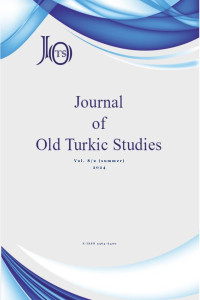Öz
Old Turkic inscriptions are among the leading sources of Turkish language, literature, history, and culture. The inscriptions provide researchers, linguists, and historians with the opportunity to learn about the language, cultural concepts, and beliefs of that period. Proverbs, idioms, and collocations in historical and contemporary texts attract attention due to the richness of the language and the cultural elements they contain. In this study, the collocations formed by verbs with voice suffixes in Old Turkic inscriptions have been examined, and the linguistic, semantic, cultural, and functional characteristics of these collocations have been investigated. Some of the results we have reached in this study are as follows: In the collocations formed with voice-suffixed verbs, the suffixes {-t}, {-gUr}, {-Ur}, and {-tUr} function as causatives and serve a functional role in the cultural conceptualization of “having something built or erected (e.g., house, bridge, monument, tomb, etc.)” and “creating a nation or army.” Since one of the primary functions of these suffixes is “causative,” it can be inferred that the structure of Turkic states during the inscription period was based on a hierarchical relationship between the lower and upper levels of society and state life. Collocations formed by verbs with the {-n} voice suffix function as “passive, reflexive, and causative”, at atan- “to be given a title or name”, el törü etin- “to have one’s homeland or customs regulated”, il qazgan- “to conquer a country or homeland”. These collocations highlight the importance of the concepts of “homeland, customs, social order, hierarchy, army, and war” during the inscription period.
Anahtar Kelimeler
Old Turkic inscriptions verbs with voice suffixes collocations cultural concepts
Kaynakça
- Besli, E. (2023). Eski Türkçe Metinlerin Kültür Dil Bilimsel Yapısında Eşdizim Algoritmaları. In Küçüker, P. & Uçar, İ. (Eds.), XV. Dünya Dili Türkçe Sempozyumu Bildiri Kitabı (pp. 210-219). Sakarya: Asos Yayınları.
- Clauson, Sir G. (1972). An Etymological Dictionary of Pre-Thirteenth Century Turkish. Oxford: Oxford University Press.
- Erdal, M. (1991). Old Turkic Word Formation, a Functional Approach to the Lexicon I-II. Wiesbaden: Harrassowitz Verlag.
- Firth, J. (1968). A Synopsis of Linguistic Theory, 1930-1955. In Palmer, F. R. (Ed.), Selected Papers of J. R. Firth (1952-1959) (pp. 168-205). London: Longmans.
- Sergeeva, T. G. (2014). Kültürdilbilimde Temel Birimlerin Tanımlanması Üzerine. Ankara: Gazi Kitabevi.
- Şirin, H. (2016). Eski Türk Yazıtları Söz Varlığı İncelemesi. Ankara: Türk Dil Kurumu Yayınları.
Öz
Old Turkic inscriptions are among the leading sources of Turkish language, literature, history, and culture. The inscriptions provide researchers, linguists, and historians with the opportunity to learn about the language, cultural concepts, and beliefs of that period. Proverbs, idioms, and collocations in historical and contemporary texts attract attention due to the richness of the language and the cultural elements they contain. In this study, the collocations formed by verbs with voice suffixes in Old Turkic inscriptions have been examined, and the linguistic, semantic, cultural, and functional characteristics of these collocations have been investigated. Some of the results we have reached in this study are as follows: In the collocations formed with voice-suffixed verbs, the suffixes {-t}, {-gUr}, {-Ur}, and {-tUr} function as causatives and serve a functional role in the cultural conceptualization of “having something built or erected (e.g., house, bridge, monument, tomb, etc.)” and “creating a nation or army.” Since one of the primary functions of these suffixes is “causative,” it can be inferred that the structure of Turkic states during the inscription period was based on a hierarchical relationship between the lower and upper levels of society and state life. Collocations formed by verbs with the {-n} voice suffix function as “passive, reflexive, and causative”, at atan- “to be given a title or name”, el törü etin- “to have one’s homeland or customs regulated”, il qazgan- “to conquer a country or homeland”. These collocations highlight the importance of the concepts of “homeland, customs, social order, hierarchy, army, and war” during the inscription period.
Anahtar Kelimeler
Old Turkic inscriptions verbs with voice suffixes collocations cultural concepts
Kaynakça
- Besli, E. (2023). Eski Türkçe Metinlerin Kültür Dil Bilimsel Yapısında Eşdizim Algoritmaları. In Küçüker, P. & Uçar, İ. (Eds.), XV. Dünya Dili Türkçe Sempozyumu Bildiri Kitabı (pp. 210-219). Sakarya: Asos Yayınları.
- Clauson, Sir G. (1972). An Etymological Dictionary of Pre-Thirteenth Century Turkish. Oxford: Oxford University Press.
- Erdal, M. (1991). Old Turkic Word Formation, a Functional Approach to the Lexicon I-II. Wiesbaden: Harrassowitz Verlag.
- Firth, J. (1968). A Synopsis of Linguistic Theory, 1930-1955. In Palmer, F. R. (Ed.), Selected Papers of J. R. Firth (1952-1959) (pp. 168-205). London: Longmans.
- Sergeeva, T. G. (2014). Kültürdilbilimde Temel Birimlerin Tanımlanması Üzerine. Ankara: Gazi Kitabevi.
- Şirin, H. (2016). Eski Türk Yazıtları Söz Varlığı İncelemesi. Ankara: Türk Dil Kurumu Yayınları.
Ayrıntılar
| Birincil Dil | Türkçe |
|---|---|
| Konular | Türk Dili ve Edebiyatı (Diğer) |
| Bölüm | Articles |
| Yazarlar | |
| Yayımlanma Tarihi | 21 Temmuz 2024 |
| Gönderilme Tarihi | 7 Temmuz 2024 |
| Kabul Tarihi | 14 Temmuz 2024 |
| Yayımlandığı Sayı | Yıl 2024 Cilt: 8 Sayı: 2 |


